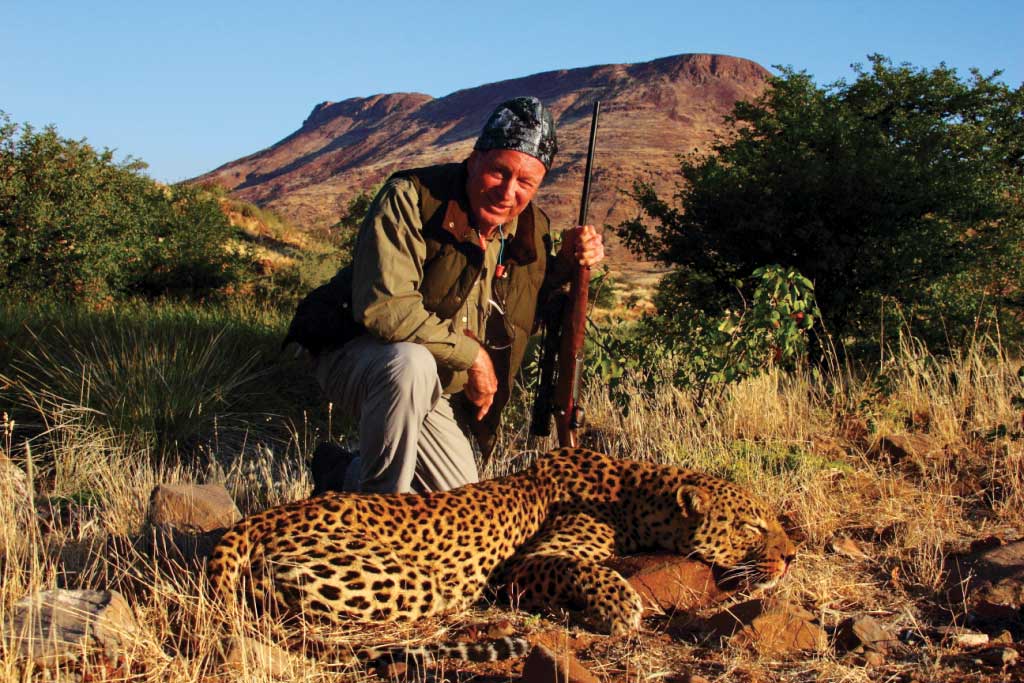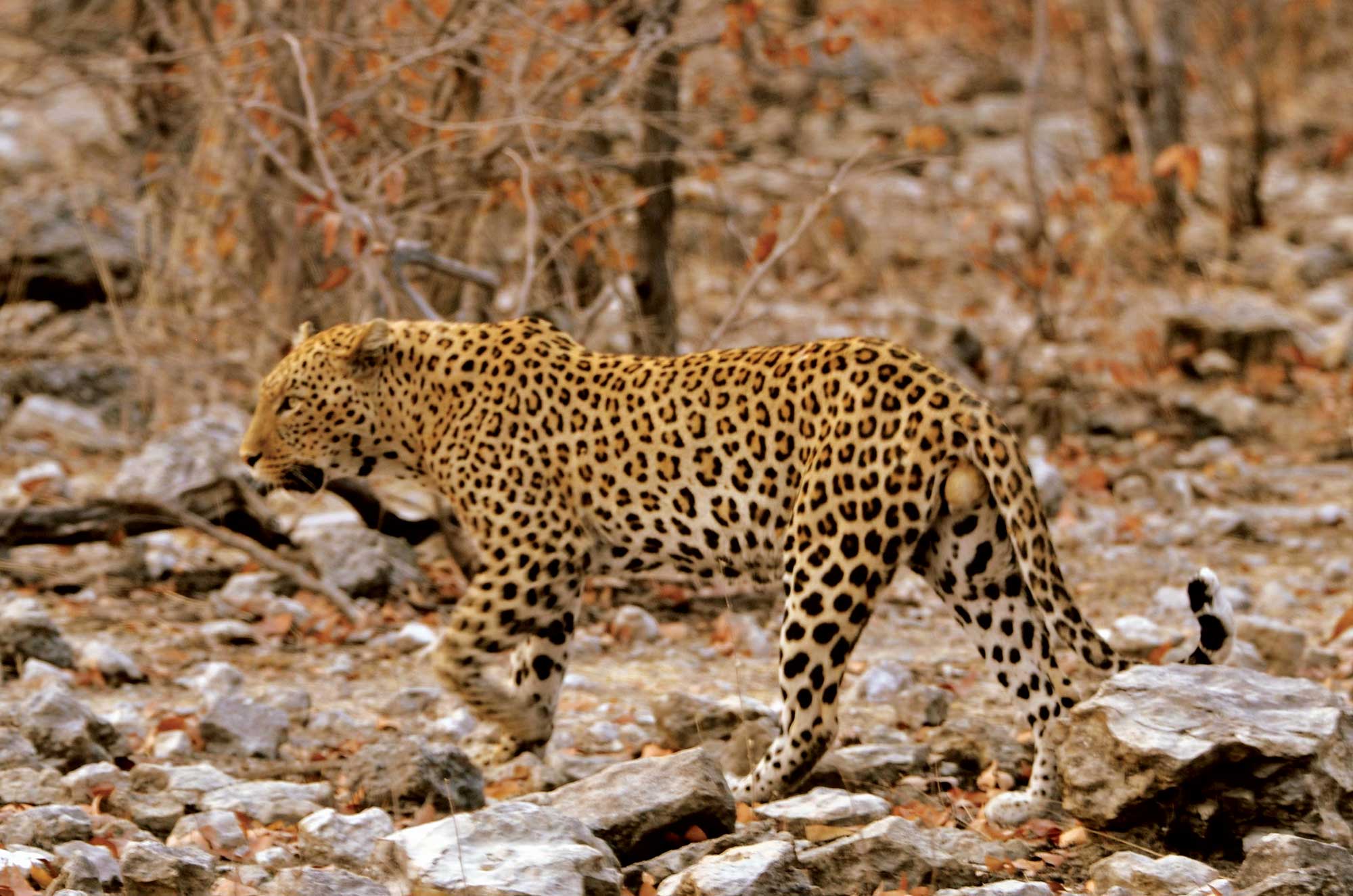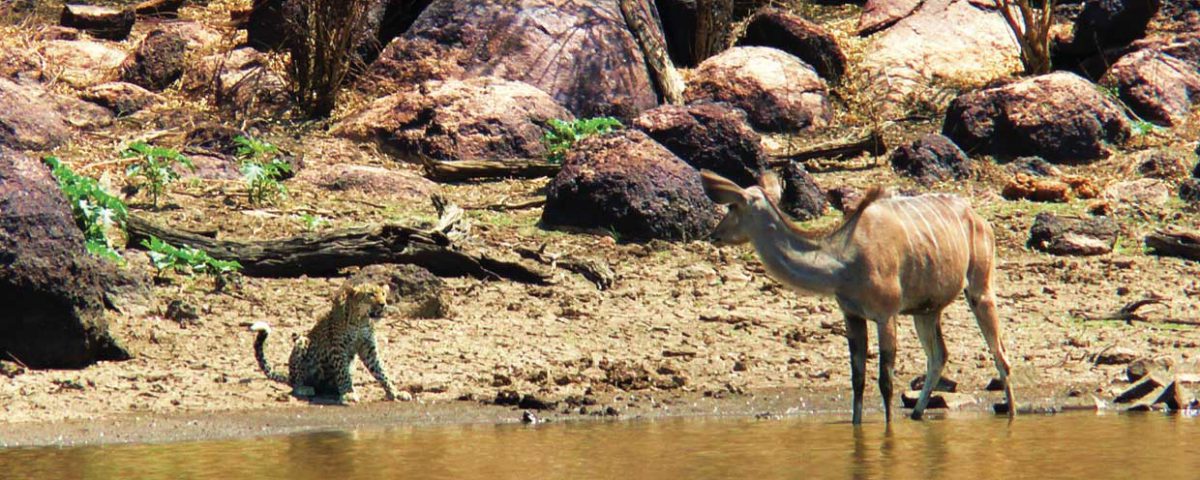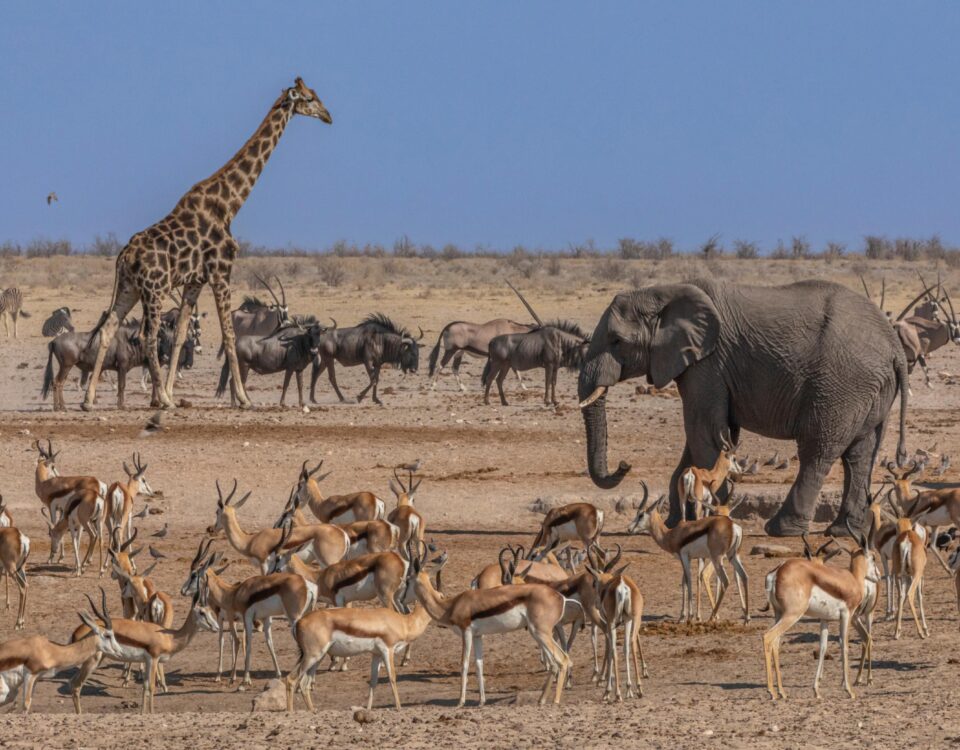
Nature’s ultimate hunter
June 9, 2016
The Tsumkwe bull
June 9, 2016T hat year’s leopard hunter had cancelled and all last-minute attempts to shoot the leopard which he had been allocated were fruitless. Things would be handled differently this year – but how should I go about it? I wasn’t all that happy with the bait sites set up by my predecessors. On two drives into the Torra concession area we saw leopards in the vicinity of the Arigana Spring. Leopard tracks on the tyre tracks confirmed the presence of big cats in this area. I had to find a suitable site for leopard baiting right here.
Ten days prior to the hunter’s arrival I drove to the hunting camp to pay the wages and to prepare the staff and the camp for the upcoming visit of the leopard hunter. In the meantime a baboon, shot on my farm, Otjitambi, was supposed to whet the leopard’s appetite. In the vicinity of the trickling spring, which is heavily frequented by springbok, oryx and mountain zebra, a small mopane tree of about two metres high caught my eye. Elephants had reduced the top of the tree to a few branches as thick as an arm. One of the branches became the baboon’s last resting place.
A week later, only a shank bone with frayed tendons was left dangling from the tree. I had to keep the supplies coming in and the following day hoisted baboon no. 2 into the young tree. A small ephemeral river course at the foot of the slope where we had seen the leopard last was perfect for another bait site. Baboon no. 3 found his final job there. A springbok and another baboon were kept in reserve at the camp to resupply the bait site as soon as the leopard had taken to it.
The next morning Tom, the hunter, arrived by charter plane. After an extensive snooze to revitalise body and mind after 36 hours of travel we set off on a game drive in the afternoon, heading for one of the vast plains where large numbers of springbok and zebra roam. Pitzi, my nephew, made us jump with his sudden exclamation “look, cheetahs”. Two cheetahs were crossing the plain at a distance of some 500 metres. What now? How were we to get there?
A bumpy track meandered across the stone strewn plain and led us in the direction where the cheetahs were. But suddenly they were gone – as if the earth had swallowed them up. A small rise next to us promised a better view. Perhaps the cheetahs were lying right behind it.
I got onto the rise with Merill, my scout and tracker, and scanned the plain for the cheetahs. They had to be somewhere in front of us. Fifteen minutes later, looking through the binoculars, I spotted a ‘rock’ which moved. Then the head of a cheetah appeared. I immediately signalled to Pitzi who was helping the elderly Tom across the difficult – damn stones – terrain. Meanwhile we piled rocks into a sort of seat. With the help of an alignment stick an accurate shot should be possible while sitting down. The only problem was that Tom couldn’t see the cheetah! After some to and fro he finally spotted the oblong ‘rock’.
“Aim for the centre!” I quickly advised before the shot went off with a bang. The ‘stone’ reared up and came to stand on four long spotted legs. Tom looked rather flummoxed, but now it was crucial that he quickly reloaded for another shot. The cheetah was already strolling off. After the second shot he accelerated a little. A good opportunity missed, I thought, when the cheetah stopped and looked to the side. The big cat seemed alarmingly small from this distance. Another shot cracked and the cheetah keeled over. I hardly believed my eyes. Tom just grinned and said, “It’s a damn flat shooting rifle.”
A test shot on the next day solved the riddle: 30 cm high at 100 metres. We had been lucky.
The bait at the spring had been received well – but by the wrong predators. Two lions and hyenas had chased the leopard away. The camera trap and the tracks testified to the nocturnal events. I immediately hung more bait into the mopane tree. A little higher this time, so that at least the hyenas couldn’t reach it. Absolutely nothing was left of the springbok half the next morning. But the lions and hyenas did not touch the baboons. We also brought baboon no. 3 to the spring and another one had to give his life so that more than enough meat could be hung into the tree and the leopard wouldn’t be able to polish off everything in one session.

“A yellow fury flung itself at us with a roar and a black arrow flew past me to safety while I turned the rifle onto the attacking leopard and pulled the trigger.”
Only a hyena prowled around the baited tree during the following two nights. Baboons simply didn’t feature on the menu of the lions and hyenas. The leopard returned and finished most of the baboons. The camera trap showed that he came to dine at different times, most recently at half past eight in the morning. Another springbok was needed. When one half of it adorned the upper branches of the tree we set up the blind approximately 50 metres away in a narrow space between two mopane bushes. The leopard was to feast on the carcass at leisure and return unsuspectingly the next evening.
The following afternoon Tom and I sat in the blind at half past three. Nothing happened until dark. Two jackals passed our hiding place at a distance of about five metres but did not notice us. A long night followed. Shortly before daybreak I heard the leopard cracking bones. At last dawn was breaking over the eastern horizon. Hopefully the big cat wouldn’t take off before we were able to see something. Little by little the silhouettes of the bushes emerged from the darkness and the leopard became visible. Slowly Tom took aim. The leopard roared out, jumped from the tree, did a pirouette and disappeared with a few grunts. This did not bode well for me – we had to search for a probably ill-tempered leopard.
When the sun rose and the first rays cast shadows in the tracks we examined the result of the shot together with Merill, the tracker, Bethuel and Joga, the scent hound. A few drops of blood were spattered next to the deep tracks of the fleeing leopard – off we were with a loaded .375 H+H double rifle.
“The leopard was to feast on the carcass at leisure and return unsuspectingly the next evening.”
Despite the tense situation I was amused by our small procession: Merill, bent forward over the track a little to the side in front of Tom and me, followed by Bethuel at a respectful distance and Joga trailing some ten metres behind us. Obviously the dog didn’t want to be involved.
The track led us to the dry riverbed which was overgrown with bulrushes. We heard a short roar ahead of us but couldn’t see the leopard. There was only the rustling of the bulrushes as he fled deeper into the undergrowth. I didn’t like this situation at all. The light breeze from behind gave an advantage to the wounded leopard.
We threw several stones into the bulrushes, but to no avail. So we decided to walk around them in order to approach the leopard against the wind. Joga would alert us if we got too close to the furious big cat. It took a lot of coaxing to persuade Joga to come to the front. Suddenly her hair bristled and she started to growl. “Go look, go, go“, I encouraged her. Now she barked at the patch of bulrushes directly in front of us. Merill slowly moved to the edge of the thicket. I stood next to him with the rifle unlocked. Merill craned his neck like a giraffe to look into the undergrowth. A yellow fury flung itself at us with a roar and a black arrow flew past me to safety while I turned the rifle onto the attacking leopard and pulled the trigger. There was no time to take aim. The large cat collapsed right in front of my feet, as if hit by lightning. That was a close one! When Bethuel pointed to Merill’s shaking legs and asked what was going on, Merill said, “I am just dancing for joy.”
I went to fetch Tom, who had retreated to the car. Delightedly he looked at his strong leopard and we had to give him a detailed account of the last part of the search. Two hours of sitting in the blind had turned into a hunt of 14 hours.
When it was time to say goodbye, a happy Tom advised “don’t let the next leopard get that close to you, I’ll be back!”

This article was first published in the HUNiNAMIBIA 2015 issue.


